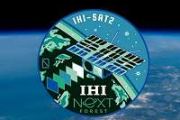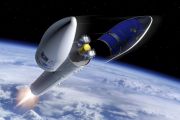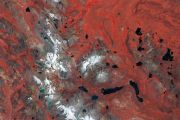
Copernical Team
The PI's Perspective: The Science Never Sleeps
 NASA's New Horizons spacecraft is healthy and speeding across the Kuiper Belt. Today, we crossed a distance marker of note, passing 60 times as far from the Sun as Earth is. Put in perspective, that means we're almost twice as far out as Pluto was when we explored it!
This summer, we had three sets of groundbased astronomical observing dates, each three days long, on the giant Japanese Sub
NASA's New Horizons spacecraft is healthy and speeding across the Kuiper Belt. Today, we crossed a distance marker of note, passing 60 times as far from the Sun as Earth is. Put in perspective, that means we're almost twice as far out as Pluto was when we explored it!
This summer, we had three sets of groundbased astronomical observing dates, each three days long, on the giant Japanese Sub Webb reveals unusual jets of volatile gas from icy Centaur 29P
 Inspired by the half-human, half-horse creatures that are part of Ancient Greek mythology, the field of astronomy has its own kind of centaurs: distant objects orbiting the Sun between Jupiter and Neptune. NASA's James Webb Space Telescope has mapped the gases spewing from one of these objects, suggesting a varied composition and providing new insights into the formation and evolution of the sol
Inspired by the half-human, half-horse creatures that are part of Ancient Greek mythology, the field of astronomy has its own kind of centaurs: distant objects orbiting the Sun between Jupiter and Neptune. NASA's James Webb Space Telescope has mapped the gases spewing from one of these objects, suggesting a varied composition and providing new insights into the formation and evolution of the sol Magnetized magma intrusions identified as sources of lunar magnetic anomalies
 A team of researchers led by Professor Shuo Yao from China University of Geosciences (Beijing) and her doctoral student Hongyi Wang has revealed that magnetized magma intrusions are the source of two lunar magnetic anomalies. Using a 3D amplitude inversion technique originally developed at the University of British Columbia's Geophysical Inversion Facility (UBC-GIF), the team has made significan
A team of researchers led by Professor Shuo Yao from China University of Geosciences (Beijing) and her doctoral student Hongyi Wang has revealed that magnetized magma intrusions are the source of two lunar magnetic anomalies. Using a 3D amplitude inversion technique originally developed at the University of British Columbia's Geophysical Inversion Facility (UBC-GIF), the team has made significan NASA selects companies for lunar communication and network studies
 NASA has chosen Intuitive Machines of Houston and Aalyria Technologies Inc. of Livermore, California, to conduct capability studies aimed at advancing space communication and exploration technologies. These studies are intended to provide NASA with insights into industry capabilities and innovations, laying the groundwork for partnerships with commercial communications and navigation providers.
NASA has chosen Intuitive Machines of Houston and Aalyria Technologies Inc. of Livermore, California, to conduct capability studies aimed at advancing space communication and exploration technologies. These studies are intended to provide NASA with insights into industry capabilities and innovations, laying the groundwork for partnerships with commercial communications and navigation providers. NASA advances Lunar rover testing for Artemis Missions
 As NASA's Artemis missions approach, astronauts returning to the Moon will be equipped with a human-rated Lunar Terrain Vehicle (LTV) to enhance their exploration of the lunar surface. The unpressurized rover will play a key role in enabling diverse scientific research and discoveries.
At NASA's Johnson Space Center in Houston, engineers are developing a prototype for the rover, known as t
As NASA's Artemis missions approach, astronauts returning to the Moon will be equipped with a human-rated Lunar Terrain Vehicle (LTV) to enhance their exploration of the lunar surface. The unpressurized rover will play a key role in enabling diverse scientific research and discoveries.
At NASA's Johnson Space Center in Houston, engineers are developing a prototype for the rover, known as t NASA's use of rover prototype on Earth will pave way for Artemis V lunar surface travel
 When astronauts eventually traverse the moon's surface as part of the planned Artemis lunar missions, they'll have a prototype to thank.
NASA engineers at the Johnson Space Center are designing a new lunar rover prototype called the Ground Test Unit. The space agency said Wednesday it plans to have the vehicle available for the Artemis V moon mission.
"The Ground Test Unit will h
When astronauts eventually traverse the moon's surface as part of the planned Artemis lunar missions, they'll have a prototype to thank.
NASA engineers at the Johnson Space Center are designing a new lunar rover prototype called the Ground Test Unit. The space agency said Wednesday it plans to have the vehicle available for the Artemis V moon mission.
"The Ground Test Unit will h NASA seeks innovators for lunar waste competition
 A new NASA competition, the LunaRecycle Challenge, is open and offering $3 million in prizes for innovations in recycling material waste on deep space missions.
As NASA continues efforts toward long-duration human space travel, including building a sustained human presence on the Moon through its Artemis missions, the agency needs novel solutions for processing inorganic waste streams like
A new NASA competition, the LunaRecycle Challenge, is open and offering $3 million in prizes for innovations in recycling material waste on deep space missions.
As NASA continues efforts toward long-duration human space travel, including building a sustained human presence on the Moon through its Artemis missions, the agency needs novel solutions for processing inorganic waste streams like Hera probe ready for near-earth asteroid study
 Asteroids have long posed a potential threat to Earth, and the European Space Agency's (ESA) Hera mission is set to explore ways to mitigate these risks. Hera, developed in Germany, will embark on a two-year journey to study the Didymos-Dimorphos asteroid system as part of an international planetary defense effort. Scheduled for launch between 7 and 27 October 2024 on a Falcon 9 rocket from Cape
Asteroids have long posed a potential threat to Earth, and the European Space Agency's (ESA) Hera mission is set to explore ways to mitigate these risks. Hera, developed in Germany, will embark on a two-year journey to study the Didymos-Dimorphos asteroid system as part of an international planetary defense effort. Scheduled for launch between 7 and 27 October 2024 on a Falcon 9 rocket from Cape An interstellar instrument takes a final bow
 They planned to fly for four years and to get as far as Jupiter and Saturn. But nearly half a century and 15 billion miles later, NASA's twin Voyager spacecraft have far exceeded their original mission, winging past the outer planets and busting out of our heliosphere, beyond the influence of the sun. The probes are currently making their way through interstellar space, traveling farther than an
They planned to fly for four years and to get as far as Jupiter and Saturn. But nearly half a century and 15 billion miles later, NASA's twin Voyager spacecraft have far exceeded their original mission, winging past the outer planets and busting out of our heliosphere, beyond the influence of the sun. The probes are currently making their way through interstellar space, traveling farther than an What is the Moon's true origin story
 Over six missions to the moon, from 1969 to 1972, Apollo astronauts collected more than 800 pounds of lunar rock and soil. Chemical and isotopic analysis of that material showed that it was similar to the rock and soil on Earth: calcium-rich, basaltic and dating to about 60 million years after the solar system formed.
Using that data, the planetary scientists who gathered at the Kona Confe
Over six missions to the moon, from 1969 to 1972, Apollo astronauts collected more than 800 pounds of lunar rock and soil. Chemical and isotopic analysis of that material showed that it was similar to the rock and soil on Earth: calcium-rich, basaltic and dating to about 60 million years after the solar system formed.
Using that data, the planetary scientists who gathered at the Kona Confe 





























